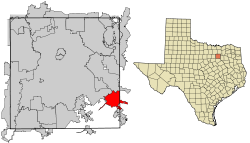Seagoville, Texas
| City of Seagoville, Texas | |
|---|---|
| City | |
 Location of Seagoville in Dallas County, Texas |
|
| Coordinates: 32°39′7″N 96°33′0″W / 32.65194°N 96.55000°WCoordinates: 32°39′7″N 96°33′0″W / 32.65194°N 96.55000°W | |
| Country |
|
| State |
|
| Counties | Dallas, Kaufman |
| Government | |
| • Type | Council-Manager |
| • City Council |
Mayor Dennis Childress Jose Hernandez Rick Howard Tommy Lemond Mike Fruin Jon Epps |
| • City Manager | Pat Stallings |
| Area | |
| • Total | 19.0 sq mi (49.2 km2) |
| • Land | 18.7 sq mi (48.4 km2) |
| • Water | 0.3 sq mi (0.8 km2) 1.58% |
| Elevation | 440 ft (134 m) |
| Population (2010) | |
| • Total | 14,835 |
| • Density | 780/sq mi (300/km2) |
| Time zone | CST (UTC-6) |
| • Summer (DST) | CDT (UTC-5) |
| ZIP code | 75159 |
| Area code(s) | 214, 469, 972 |
| FIPS code | 48-66428 |
| GNIS feature ID | 1346844 |
| Website | seagoville.us |
Seagoville (/ˈsiːɡoʊvɪl/ SEE-goh-vil) is a city in Dallas County, Texas, United States, and a suburb of Dallas. A small portion of Seagoville extends into Kaufman County. The population was 14,835 at the 2010 census. The city is located along U.S. Highway 175, 10 miles (16 km) from downtown Mesquite.
Seagoville was originally called Seago, and under the latter name was laid out in 1876 by T. K. Seago (1836–1904), and named for him. The United States Post Office changed the town's name to "Seagoville" in 1910 to prevent confusion with another city in Texas called Sego.
During World War II, the Federal Reformatory for Women in Seagoville was the site of a Immigration and Naturalization Service detention camp for Japanese, German and Italian Americans classified as "enemy aliens" and women of Japanese and German ancestry deported from Latin America. Internees at Seagoville published a German language newsletter called the Sägedorfer Fliegende Blätter. The camp housed up to 647 people, and was closed in June 1945, after the internees were either "repatriated" to Japan or Germany, or transferred to Crystal City, Texas.
...
Wikipedia
